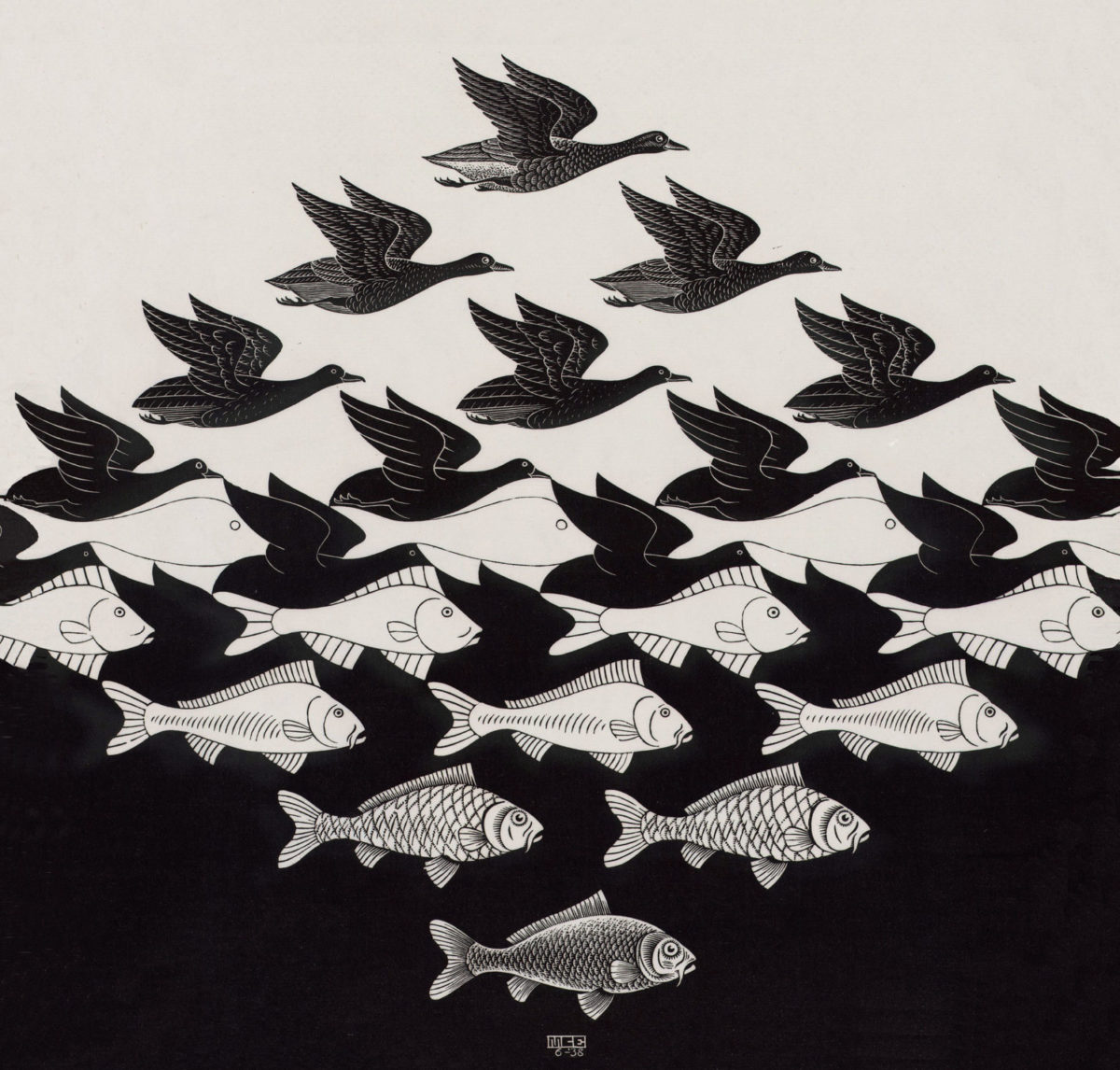Most people would recognise the work of Maurits Cornelis Escher: the impossible waterfall, the staircase which simultaneously rises and falls, the hands reaching out of the paper and drawing each other. But few could name him, and even fewer know anything about his life and work. They may not even know that there is a “he” at all, since his works are of such precision and detail that they seem almost computer-generated to the modern eye.
Indeed, the artist was relatively anonymous until late in his own life. He was 70 years old before a retrospective exhibition of his work was organised even in the Netherlands, and it was only in 1966, when Martin Gardner used one of Escher’s illustrations in his “Mathematical Games” in Scientific American, that the world paid much attention. After that, Escher became popular in the mathematical community as well as in the art world, and also found himself an unlikely hero of popular culture, featuring on album cover by The Scaffold and Mott the Hoople.
Escher himself sometimes played with the idea of making a film, though he declared that it would be very boring. Now, Dutch director Robin Lutz has teamed up with art historian Marijnke de Jong to create a documentary of the artist’s life, entitled M.C. Escher: Journey to Infinity (released in selected cinemas, 5 February).
The genesis of the film lies five years ago, when Lutz and de Jong had finished a previous project and were discussing what to do next. The idea of a film about Escher came up but remained at the conceptual stage until it was revived in 2018, when Leeuwarden, Escher’s birthplace, was European Capital of Culture. The difficulty of raising finance for a niche independent film, added to the restrictions of the Covid-19 pandemic, delayed the completion of the project and it has only now been released.
Journey to Infinity is a documentary based on Escher’s own writings, which are narrated by Stephen Fry (himself a great enthusiast for the artist). Lutz explains the choice of format:
“When you read his books, or his lectures or things like that, he’s not a very inspiring person. But he it turned out that he was a very good writer and that he had emotions and was not a dry mathematician, and that there were deeper thoughts behind his work. And that was interesting.”
De Jong adds that Escher’s own remark about a film of his work being boring acted as a challenge to them. “Let’s try to make a documentary in which he himself is telling in his own words”, she concludes. They also decided that the narration had to be drawn entirely from Escher’s words. “We promise the world Escher is telling his story”, says Lutz, “and it is Escher 100% and not 99% Escher and 1% Robin Lutz.”
Creating animations based on Escher’s famously impossible perspectives proved a technical challenge. It is a standard film-making technique to provide animated visuals to accompany narration, but the computer generation was baffled by the paradoxes of Escher’s designs. “The computer couldn’t make sense out of it”, Lutz recalls.
You have to draw by hand, image-by-image, to direct the curve to go down and not to go up, or to go down and to make it match. You have software. But in this case, you have to tell the software image-by-image what it has to do.
One of the great difficulties in assessing Escher and his legacy is in defining him, something he sought to avoid. He was a student of architecture and the decorative arts before becoming transfixed by the mathematics of tessellation, and gradually his work changed from being observational, often drawn in the field, to the more technical, precise and imagined form with which we are familiar.
For a graphic artist, to use that description, to be so well known is unusual, argues de Jong. His work is not often seen in museums because it is on paper, small in scale and fragile with the progress of time. Modern technology has, though, had a profound effect on Escher’s influence and legacy. De Jong continues:
“When you look around and when you Google, for instance, ‘Escher’, his inventions are everywhere, in the DNA also of youngsters now. Were his inventions an inspiration? And in his time, I think he was very unique in the sense that he was, in fact, a conceptual artist, because he was striving to grab an abstract idea like infinity.”
She concludes that Escher is “very difficult to compare with anybody”, and that must surely be the case. His is a unique journey.
The film is now available online through selected US cinema and websites. As an art film it will have to compete for a slice of a specialist market, but the name of Fry as narrator should help it, at least in the UK. Perhaps this is the sort of production for which the pandemic could have been designed: we are spending more and more time in front of screens, consuming more and more content, but our palates are craving ever-more unusual and exotic fare. This may be a propitious time to find an audience for the exploration of a singular artist.
M.C. Escher: Journey to Infinity (1 hr 21 mins, available in virtual cinemas). See the trailer here.

